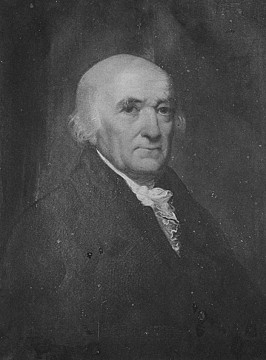Nathaniel Russell (1738-1820)
Merchant & Slave Trader, of 51 Meeting Street, Charleston, South Carolina
He was born at Bristol, Rhode Island. One of his first cousins was the father of Russell Sturgis, the prominent merchant and hatter of Boston. He began his business career in partnership with Russell Durfee in Newport. Moving down to Charleston in 1765 to represent their firm, the business was quickly dissolved and after an equally unsuccessful stint on his own account he was set to return north in 1769 when he was contacted by Nicholas Brown & Co. Becoming their agent in Charleston, he exported rice, hemp, indigo, tar, pitch, pork and Indian corn while importing rum, sugar, molasses, oil, candles and pimento. In addition to working with Brown & Co., he began to represent other firms both in America and Europe who sent him household goods, and slaves. The latter proved substantially more lucrative than anything else, and payments were prompt.
His new found wealth saw him purchase 400-acres on the Santee River, commercial property on Charleston's dock front, a house on East Bay Street, and he invested just over £11,000 in South Carolina bonds. In 1780, he was elected to the South Carolina General Assembly, but when the British occupied the town he fled to London. Returning in 1783, he managed to avoid the fines levied at other Tories and continued his mercantile activities, still with an emphasis on slave-trading. After his marriage in 1788 to the daughter of William Hopton, as well as his commercial property, he owned a 1,150-acre plantation on the Wando River and 25-slaves. His wife's family gave him access to the low-country aristocracy and his brothers-in-law now included the partners of Powell, Hopton & Co., one of the five largest slave trading firms in South Carolina prior to the Revolution. By the time he died in 1820, Russell was considered "the prince of Charleston merchants".
Nathaniel Russell is best remembered today for one of Charleston's most treasured architectural gems - and one of the most important Neoclassical houses in the United States - the magnificent mansion (see images) he built from 1803 to 1808 at 51 Meeting Street which cost him over $60,000 to complete. The Russell's position in society was sealed in 1808 when they announced the engagement of their elder daughter, Alicia, to Arthur Middleton, grandson of the builder of Middleton Place. Their younger daughter, Sarah, made an equally opportune marriage to the Bishop of South Carolina, and although widowed by the time of her father's death, she moved into the family mansion.
His new found wealth saw him purchase 400-acres on the Santee River, commercial property on Charleston's dock front, a house on East Bay Street, and he invested just over £11,000 in South Carolina bonds. In 1780, he was elected to the South Carolina General Assembly, but when the British occupied the town he fled to London. Returning in 1783, he managed to avoid the fines levied at other Tories and continued his mercantile activities, still with an emphasis on slave-trading. After his marriage in 1788 to the daughter of William Hopton, as well as his commercial property, he owned a 1,150-acre plantation on the Wando River and 25-slaves. His wife's family gave him access to the low-country aristocracy and his brothers-in-law now included the partners of Powell, Hopton & Co., one of the five largest slave trading firms in South Carolina prior to the Revolution. By the time he died in 1820, Russell was considered "the prince of Charleston merchants".
Nathaniel Russell is best remembered today for one of Charleston's most treasured architectural gems - and one of the most important Neoclassical houses in the United States - the magnificent mansion (see images) he built from 1803 to 1808 at 51 Meeting Street which cost him over $60,000 to complete. The Russell's position in society was sealed in 1808 when they announced the engagement of their elder daughter, Alicia, to Arthur Middleton, grandson of the builder of Middleton Place. Their younger daughter, Sarah, made an equally opportune marriage to the Bishop of South Carolina, and although widowed by the time of her father's death, she moved into the family mansion.
Parents (2)
Categories
Share
Image Courtesy of the Frick Art Reference Library; The Final Victims
Foreign Slave Trade to North America, 1783-1810, by James McMillin (2004).



